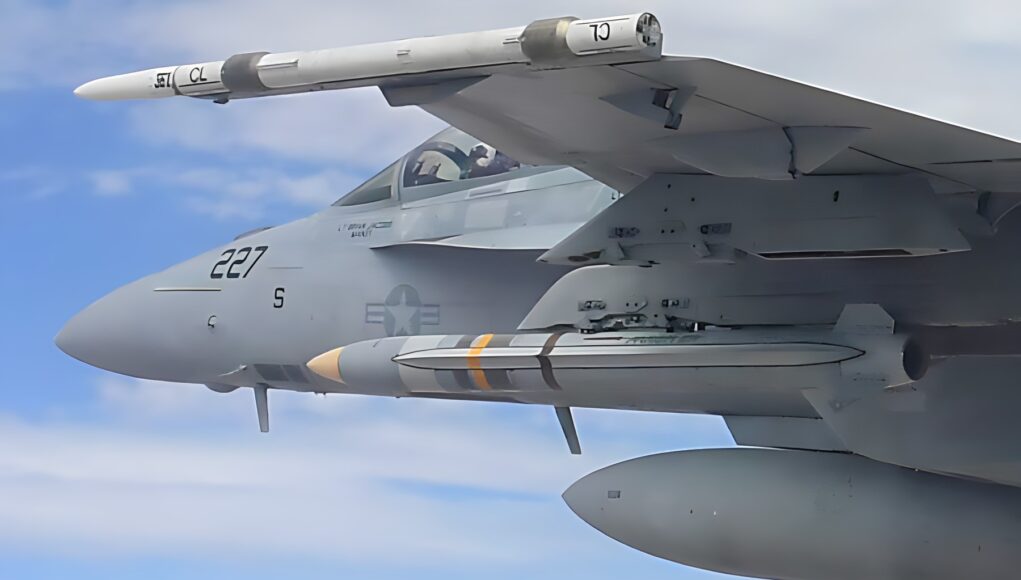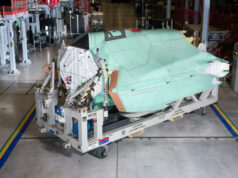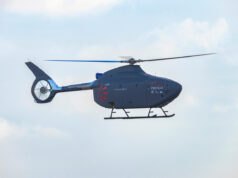The U.S. State Department has approved a potential £332 million ($405 million) foreign military sale to Australia for Advanced Anti-Radiation Guided Missiles-Extended Range (AARGM-ER) and related equipment.
The Defence Security Cooperation Agency formally notified Congress of the possible sale on 27 September 2024.
According to the official notice, Australia has requested to purchase “up to one hundred (100) Advanced Anti-Radiation Guided Missiles-Extended Range (AARGM-ER) with global positioning system (GPS) precise positioning system (PPS)” supported by either the “Selective Availability Anti-Spoofing Module (SAASM) or M-Code.”
The sale also includes “up to twenty-four (24) AGM-88G AARGM-ER guidance sections (spares)” and “up to twenty-four (24) AGM-88G AARGM-ER control sections (spares).” Additionally, the package will cover missile containers, spare parts, training, software (both classified and unclassified), and engineering support.
The U.S. government highlighted that the sale “will support the foreign policy and national security objectives of the United States.” As one of America’s most important allies in the Western Pacific, Australia’s strategic location is essential for “ensuring peace and economic stability” in the region.
The proposed sale “will improve the Government of Australia’s capability to meet current and future threats by providing the capability to suppress and destroy land or sea-based radar emitters associated with enemy air defences,” thus enhancing the survivability of its tactical aircraft.
The notice also reassured that the sale “will not alter the basic military balance in the region,” and that Australia “will have no difficulty absorbing this equipment into its armed forces.” The principal contractor for the sale will be Northrop Grumman Systems, based in Falls Church, Virginia. Furthermore, the transaction will not affect U.S. defence readiness, with only a small team of “approximately four U.S. Government and one contractor representative” required to travel to Australia temporarily for programme oversight.
The final cost of the sale may be lower than the estimated £332 million, depending on “final requirements, budget authority, and signed sales agreement(s).”
The Advanced Anti-Radiation Guided Missile-Extended Range (AARGM-ER) is specifically designed for the Suppression and Destruction of Enemy Air Defenses (SEAD/DEAD). Its primary targets include relocatable Integrated Air Defense (IAD) systems and radar sites that employ shutdown tactics to evade detection.
One of its key features is the use of a multi-mode seeker, which allows the missile to track and engage targets even when they attempt to shut down their systems. This makes the AARGM-ER a critical asset for disrupting enemy air defences and ensuring the survivability of allied aircraft in contested environments.
Building on the capabilities of the earlier AGM-88E AARGM, the Extended Range version incorporates significant hardware and software upgrades to enhance its range, survivability, and effectiveness against emerging threats.














Is the UK going to use a variant of Spear 3 for this task?
Look at it another way.
An anti radiation missile takes out an emitter that it can passively detect?
There is nothing stopping the radiation detection being done from another platform and the coordinates fed back to the missile.
So it follows that anything precise that can take mid course corrections can do the job.
OK with a caveat that they need to be able to zero in on the key bits of the setup [command and control unit – perhaps?] rather than that radar itself…so that required optical recognition if some kind on the seeker.
So there are other ways to slice and dice this without creating another massively expensive inventory.
“there is nothing stopping”
There certainly is, an entire theater of the battlespace – electronic warfare. Anything using a datalink can be jammed. We’re seeing that in Ukraine.
Everyday is a schoolday. Thx 😊
This is Spear-3’s primary role, which is why it is on the weapons integration list for the F35. For suppression of enemy air defences (SEAD) or destruction of enemy air defences (DEAD), there is nothing comparable to what the F35 brings to the party. Which is why the standard Spear-3 will be such a highly effective weapon when teamed with the F35.
The F35 has the sensors built-in to detect and categorize RF threats. The aircraft’s very low radar cross section along with holding weapons in the two bays, allows it to operate much closer to air defence systems. Doing the same with a Typhoon would be inviting trouble.
The 2nd variant of Spear-3 the Electronic Warfare version. Dispenses with the warhead and replaces it with a version of Leonardo’s Britecloud active RF jammer. Spear-EW is designed to blind or fool the air defence system’s radar. Which could track the Spear and try to shoot it down. By blinding the radar there is a greater chance for the standard Spears to attack their specific targets. The Air defence system will then have to rely on either an optical or infrared sensor to detect and track the Spear. Which if flying at very low level won’t give them much of a chance to react. The Spear-EW does have a suicide mode to dive into a target as a means of self-destruction and adding to the carnage.
Even though Spear is a relatively high speed subsonic missile compared to the Mach 3 HARM. By using it from the F35 should mitigate this issue.
Wow! Star Wars stuff. Thx
Interesting post Davey B, thanks Mate
“Which is why the standard Spear-3 will be such a highly effective weapon when teamed with the F35.”
Isn’t that the million dollar question though – exactly when that will be.
Hasn’t that date has been extended and extended due to hardware upgrades, engine upgrades and most importantly block 4 – I’m not even sure when thats supposed to be now tbh?
The Aussies seem to be getting some decent kit over the last few years- couple that with the AUKUS stuff and their forces appear to be developing some credibility.
What I can say is Spear will be first integrated on Typhoon. Primarily as a trials aircraft, but then aiming for FOC. However, through the UOR route, Spear could be fitted to the F35 earlier. But with the caveat of limited capability from the platform to the missile, ie same as fitting Storm Shadow to the SU-24.
Agree on the current F35 upgrade timeline. It is years behind and is causing lots of repercussions. Sadly we have no control over it. Though I’ve heard BAe are now helping with the coding. So the updates may be coming sooner rather than later.
How much more expensive will Spear be than Brimstone?
Is the idea to completely replace Brimstone on Typhoon?
Not sure on the cost difference, but Spear will be more expensive, as it is a more complex weapon.
Spear can do the same mission roles that Brimstone can do. But Brimstone can’t do the same as Spear. I don’t believe the RAF will stop buying Brimstone, aA it’s not only proved to be a highly effective weapon but will be quite a bit cheaper than Spear. So for the asymmetric missions like taking out Isis, it’s still ideal.
The Spear EW suicide mode sounds interesting, that’s the first I’ve heard on that.
Do you think it would be possible to make a faster Spear? Exchange part of the range for brimstone speed around mach 2? Ideally you would retain all of the avionics but just swap out the jet for a rocket motor and maybe shorten the wings as well.
Thanks for the excellent post.
Hi SB, MBDA have intimated on the suicide mode for Spear. As they’ve said that the missile can be used to kinetically attack a target. Where it is expected that any unused fuel adds to any conflagration from the strike.
There are a number of ways to make Spear faster, but at the expense of range. This can be done without any major changes to the airframe or engine.
Looking at the engine first. It is a pretty basic turbojet. Which is a must, as the engine must always work first time even if it’s been on the shelf for 5 years or more. We could introduce an afterburner. Which should nearly double the thrust. However it will drastically reduce the range, probably by half, ie about 70km max. Though it will be capable of being throttleable. Which may mitigate some of the range issues.
The second item to look at are the main wings that fold out in flight. After release from the aircraft. The Spear rolls over 180 degrees and the main wings pop out. These are set to generate sufficient lift at 500mph+ to balance out the thrust from the engine.
As the aircraft goes faster the wing will generate more drag. This can be mitigated by sweeping the wings further back. In general the wing generates less drag when swept further back. Therefore, if the wing’s sweep could be controlled in flight. It can then be swept to match the speed.
By using both of the above methods, you should be able make Spear supersonic. Mach 2 would be too much of an ask for the current engine. Realistically you would need a rocket or ramjet to allow Spear to reach Mach 2, especially if you must keep the airframe size as it is. The other thing to have a look at are the tail fins, as they might be too large for supersonic speeds, ie overpowered.
Could a Meteor-style ramjet be used?
I understand that the intakes might not be suitable, but could they be added without affecting the number that fit in an F35?
Surely that and optimising the lift and control surfaces would allow Mach 2?
Say, a shorter wing along the lines of Land Precision Strike?
To use the ramjet it will need either the platform accelerating to Mach 1.4 or have a rocket booster to get it up to speed. As it won’t work at slower speeds. You could use a similar arrangement to Meteor, where the combustion chamber and exhaust if the ramjet holds the rocket booster. Here we will have slight issue due to the exhaust nozzle requirements. For acceleration you want a large area nozzle, but for cruising you want a smaller one. So without getting into complex variable area nozzles. You will have to compromise on a fixed size and accept that the ramjet will be generating a lot more thrust.
As per Meteor you can do away with the main wings. Using the missile body to fly at a certain angle of attack to generate lift.
The main compromise now will be the shape of the nose. Both Brimstone and Spear use a multi-sensor seeker. Where it combines active/passive radar and a semi-active laser sensor. Which means for the laser sensor to work you require an optically perfect window. Hence the hemispherical glass window in the nose. However, this compromises the aerodynamics, as it generates a high pressure area right on the nose. Creating complex airflow around the nose as well as drag. Which isn’t great for top speed.
To summarize, yes you could use a ramjet and modify the airframe to include bigger air intakes. Plus get rid of the pop out main wing, even doing away with the wing all together. A compromise on the top speed will need to be made due to the nose shape. But the ramjet should be able to propel a Spear between Mach 2 and 3, maybe higher. It will depend on how big the volume of fuel is, plus how hot the nose gets. If the same method is used from the Meteor, you could also include the ability to throttle the ramjet.
Is laser guidance feasible for such a missile?
It would presumably have c.60km range and be significantly more expensive than either Spear or Brimstone.
In that case it probably isn’t worth using against any target that needs laser guidance instead of radar or GPS/INS.
Now, would these changes make it impossible to fit 4 in an F35? They’re pretty tight length wise already.
Yes, semi active laser homing (SALH) will still be doable at Mach 3. An example I can give you is to look at ASRAAM. Ok it doesn’t have SALH, but it requires a round nose for the optical glass window, so that the IR sensor has 180 degrees freedom of movement and tracking for elevation and azimuth. ASRAAM is a Mach 3+ missile, the glass is designed to cope with the heat build up.
I think you could scale the Meteor’s ramjet to fit in the Spear airframe. The question would be, will there still be enough room for a sufficient amount of fuel? The issue is that a ramjet needs to be a certain proportion to work ie the combustion chamber shape and volume is x and the exhaust length is y. The big benefit of the turbojet Spear uses, is that it is very compact. Thereby allowing more space for fuel.
The first question you need to ask though, is what is the missile required for? Ie what will be its primary target. Once you know that you can then build the missile’s parameters around the requirement.
The idea was to provide a quicker response time for the F35.
Say you have a jet on CAP above the battlefield, with a multirole loadout, both Meteor and Spear. You detect a Pantsir site, say, 60km away, but it is still setting up and will be able to defend itself against your missile load in 5 minutes.
Or maybe you receive a report of a tank crossing a narrow gap between covered forests.
Or maybe a unit of Boxer has encountered tanks further along the front
In both cases there is only a short window of opportunity to destroy the target before it either is no longer available to hit or kills some of your own side.
Given that there might be multiple targets and that will be targets of opportunity, there needs to be an ability to carry multiple alongside other payloads.
Ok, I’m tying myself up in knots justifying this missile, but the basic idea is a Brimstone-ER with the new tech from Spear and launchable from F35.
Assume from your comments Spear 3 will have a low altitude terminal approach? While this could shield it from radar detection, its subsonic speed combined with relative low approach could make it vulnerable to ground based fire compared to AARGM.
Also seems to suggest that a Spear 3 EW would need to be salvoed with a standard Spear 3 to successfully evade defensive radar?
The Mach 2.9 AARGM-ER has a standoff range of 300km, more than twice that of Spear 3 and a 68kg warhead (double Spear?).
So while Spear 3 would strike its target at max range in 7.5 minutes, AARGM-ER takes 5 minutes with twice the standoff. Put another way, launched at the same point as Spear 3, AARGM-ER would close on its target in 150 seconds making it harder to counter.
Hope for the RAF’s sake Spear 3 is operational soon. The RAAF already has a decent SEAD/DEAD capability with the in-service AGM88 and soon to be significantly enhanced with the AARGM-ER which it needs against long range integrated air defence systems operational in the Pacific.
Of course when Spear is integrated into the F35 it would also become an option for the RAAF. Best of both worlds!